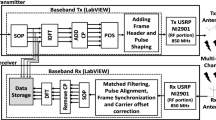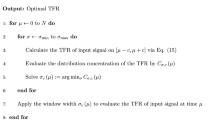Abstract
To improve the speech intelligibility in noisy environments for persons with hearing impairments, a new method for reducing noise, based on improved sub-band signal-to-noise ratio (SNR) estimation, is proposed. First, the input signal is decomposed into several sub-band signals with an analysis filter bank. Then, under the assumption of a Gaussian model, maximum a posterior probability is applied to estimate the information embedded in adjacent frames in each sub-band, which is in the form of a joint probability density function, and the minimum of the noise spectrum is tracked to estimate the noise. Subsequently, the gain of each sub-band, which changes with the noise in the corresponding sub-band, is calculated with a linear proportional gain function. The obtained gains of the sub-bands are multiplied by the sub-band noisy signals to obtain the enhanced sub-band speech signals. Finally, all the sub-band signals are spliced to obtain the estimated speech signals. In this algorithm, the gains are calculated in the time domain, which avoids the process of the inverse Fourier transform and leads to a decrease in computational complexity. Compared with the traditional spectral subtraction and basic Wiener filtering method, the delay in this algorithm is reduced by 40.4 and 60.6%, respectively. It is also compared with the modulation depth integrated into hearing aids under an experimental simulation and a real scenario. The results indicate that the output SNR is improved by 1 dB under the software simulation and 3.1 dB in the real scenario when the input SNR is set as 10 dB. Compared with the simulation environment, the proposed algorithm only fell by 1.5% in the real scenario. Furthermore, the distance of the logarithmic spectrum and quality of speech perception are improved by 20.6 and 9.3%, respectively.










Similar content being viewed by others
References
B. Acar, M.F. Yurekli, M.A. Babademez, H. Karabulut, R.M. Karasen, Effects of hearing aids on cognitive functions and depressive signs in elderly people. Arch. Gerontol. Geriatr. 52(3), 250–252 (2011). doi:10.1016/j.archger.2010.04.013
R. Aggarwal, J.K. Singh, V.K. Gupta, S. Rathore, M. Tiwari, A. Khare, Noise reduction of speech signal using wavelet transform with modified universal threshold. Int. J. Comput. Appl. 20(5), 14–19 (2011)
S.F. Boll, Suppression of acoustic noise in speech using spectral subtraction. IEEE Trans. Acoust. Speech Signal Process. 27(2), 113–120 (1979)
K.S. Chong, B.H. Gwee, J.S. Chang, A 16-channel low-power nonuniform spaced filter bank core for digital hearing aids. IEEE Trans. Circuits Syst. II Express Br. 53(9), 853–857 (2006)
R. Chou, T. Dana, C. Bougatsos, C. Fleming, T. Beil, Screening adults aged 50 years or older for hearing loss: a review of the evidence for the US preventive services task force. Ann. Int. Med. 154(5), 347–355 (2011)
K. Chung, Challenges and recent developments in hearing aids part I. Speech understanding in noise, microphone technologies and noise reduction algorithms. Trends Amplif. 8(3), 83–124 (2004)
I. Cohen, Noise spectrum estimation in adverse environments: improved minima controlled recursive averaging. IEEE Trans. Speech Audio Process. 11(5), 466–475 (2003)
K.L. Cummins, K.E. Hecox, M.J. Williamson, Adaptive, programmable signal processing hearing aid, in EP (1989)
B. Edwards, The future of hearing aid technology. Trends Amplif. 11(1), 31–46 (2007)
M.A.A. El-Fattah, M.I. Dessouky, A.M. Abbas, S.M. Diab, E.-S.M. El-Rabaie, W. Al-Nuaimy, S.A. Alshebeili, F.E.A. El-Samie, Speech enhancement with an adaptive Wiener filter. Int. J. Speech Technol. 17(1), 53–64 (2014)
Y. Ephraim, D. Malah, Speech enhancement using a minimum mean-square error log-spectral amplitude estimator. IEEE Trans. Acoust. Speech Signal Process. 33(2), 443–445 (1985)
X. Fang, M.J. Nilsson, Noise reduction apparatus and method, in US (2004)
B. Gopinath, J. Schneider, D. Hartley, E. Teber, C.M. McMahon, S.R. Leeder, P. Mitchell, Incidence and predictors of hearing aid use and ownership among older adults with hearing loss. Ann. Epidemiol. 21(7), 497–506 (2011)
Y. Gui, H.K. Kwan, Adaptive subband Wiener filtering for speech enhancement using critical-band gammatone filterbank. Midwest Symp. Circuits Syst. 731, 732–735 (2005)
A. Hogan, K. O’Loughlin, P. Miller, H. Kendig, The health impact of a hearing disability on older people in Australia. J. Aging Health 21(8), 1098–1111 (2009)
M.T. Islam, C. Shahnaz, W.-P. Zhu, M.O. Ahmad, Rayleigh modeling of teager energy operated perceptual wavelet packet coefficients for enhancing noisy speech. Speech Commun. 86, 64–74 (2017)
Y. Jiang, R. Liu, Binaural deep neural network for robust speech enhancement, in 2014 IEEE International Conference on Signal Processing, Communications and Computing (ICSPCC) (2014), pp. 692–695
S. Kamath, P. Loizou, A multi-band spectral subtraction method for enhancing speech corrupted by colored noise, in IEEE International Conference on Acoustics Speech and Signal Processing (Citeseer, 2002), pp. 4164–4164
H. Katahira, N. Ono, S. Miyabe, T. Yamada, S. Makino, Nonlinear speech enhancement by virtual increase of channels and maximum SNR beamformer. EURASIP J. Adv. Signal Process. 2016, 11 (2016)
S.M. Kay, Fundamentals of Statistical Signal Processing: Estimation Theory (1993), pp. 342–343. doi:10.2307/1269750
M.C. Killion, P.A. Niquette, What can the pure-tone audiogram tell us about a patient’s SNR loss? Hear. J. 53(3), 46–48 (2000)
A. Laplante-Lévesque, L. Hickson, L. Worrall, Rehabilitation of older adults with hearing impairment: a critical review. J. Aging Health 22, 143–153 (2010)
J. Lei, J. Wang, Z. Yang, Robust voice activity detection based on spectral entropy and two-stage mel-warped Wiener filtering (IEEE, 2008) pp. 306–309
F.R. Lin, R. Thorpe, S. Gordon-Salant, L. Ferrucci, Hearing loss prevalence and risk factors among older adults in the United States. J. Gerontol. Ser. A: Biol. Sci. Med. Sci. 66(5), 582–590 (2011)
R. Martin, Noise power spectral density estimation based on optimal smoothing and minimum statistics. IEEE Trans Speech Audio Process. 9(5), 504–512 (2001)
S. Mavaddaty, S.M. Ahadi, S. Seyedin, Speech enhancement using sparse dictionary learning in wavelet packet transform domain. Comput. Speech Lang. 44, 22–47 (2017)
M.A.B. Messaoud, A. Bouzid, Speech enhancement based on wavelet transform and improved subspace decomposition. J. Audio Eng. Soc. 63(12), 990–1000 (2016)
S.-F. Ou, X.H. Zhao, MAP estimation for noisy speech enhancement based on inter-frame correlation. Acta Electron. Sin. 35(10), 2007–2013 (2007)
J.W. Seok, K.S. Bae, Speech enhancement with reduction of noise components in the wavelet domain, in 1997 IEEE International Conference on Acoustics, Speech, and Signal Processing, 1997. ICASSP-97 (IEEE, 1997), pp. 1323–1326
H.W. Tseng, M. Hong, Z.Q. Luo, Combining sparse NMF with deep neural network: a new classification-based approach for speech enhancement, in 2015 IEEE International Conference on Acoustics, Speech and Signal Processing (ICASSP) (2015)
Q. Wang, R. Liang, Z. Zou, L. Zhao, Sub-band noise reduction in multi-channel digital hearing aid. IEICE Trans. Inf. Syst. E99.D(1), 292–295 (2016)
J. Wouters, J.V. Berghe, Speech recognition in noise for cochlear implantees with a two-microphone monaural adaptive noise reduction system. Ear Hear. 22(5), 420–430 (2001)
S. Wyrsch, A. Kaelin, Subband signal processing for hearing aids. In: Proceedings of the 1999 IEEE International Symposium on Circuits and Systems, 1999. ISCAS ’99, vol. 23 (Jul 1999), pp. 29–32
L.C. Yang, Q.Y. Tao, W.W. Hong, A GSC algorithm based on null spectral subtraction for dual small microphone array speech enhancement. Zhejiang Daxue Xuebao (Gongxue Ban)/J. Zhejiang Univ. (Eng. Sci. Ed.) 47(8), 1493–1499 (2013)
P. Yotam, R. Boaz, Objective performance analysis of spherical microphone arrays for speech enhancement in rooms. J. Acoust. Soc. Am. 132(3), 1473–1481 (2012)
Y. Zhang, Y. Zhao, Real and imaginary modulation spectral subtraction for speech enhancement. Speech Commun. 55(4), 509–522 (2013)
Acknowledgements
The work was supported by the National Natural Science Foundation of China under Grant Nos. 61673108 and 61375028, China Postdoctoral Science Foundation funded Project under Grant No. 2016M601696, Qing Lan Project of Jiangsu Province, Six Talent Peaks Project in Jiangsu Province under Grant No. 2016-DZXX-023, Jiangsu Planned Projects for Postdoctoral Research Funds under Grant No. 1601011B, the High-level Scientific Research Foundation of NJIT under Grant No. YKJ201526 and the open fund of Guangdong lighting and audio video engineering research center under Grant Nos. KF201601 and KF201602. The authors would like to thank the reviewers for their valuable suggestions and comments.
Author information
Authors and Affiliations
Corresponding author
Ethics declarations
Conflict of interest
All authors declare that they have no conflict of interest.
Rights and permissions
About this article
Cite this article
Jiang, T., Liang, R., Wang, Q. et al. Speech Noise Reduction Algorithm in Digital Hearing Aids Based on an Improved Sub-band SNR Estimation. Circuits Syst Signal Process 37, 1243–1267 (2018). https://doi.org/10.1007/s00034-017-0605-7
Received:
Revised:
Accepted:
Published:
Issue Date:
DOI: https://doi.org/10.1007/s00034-017-0605-7




